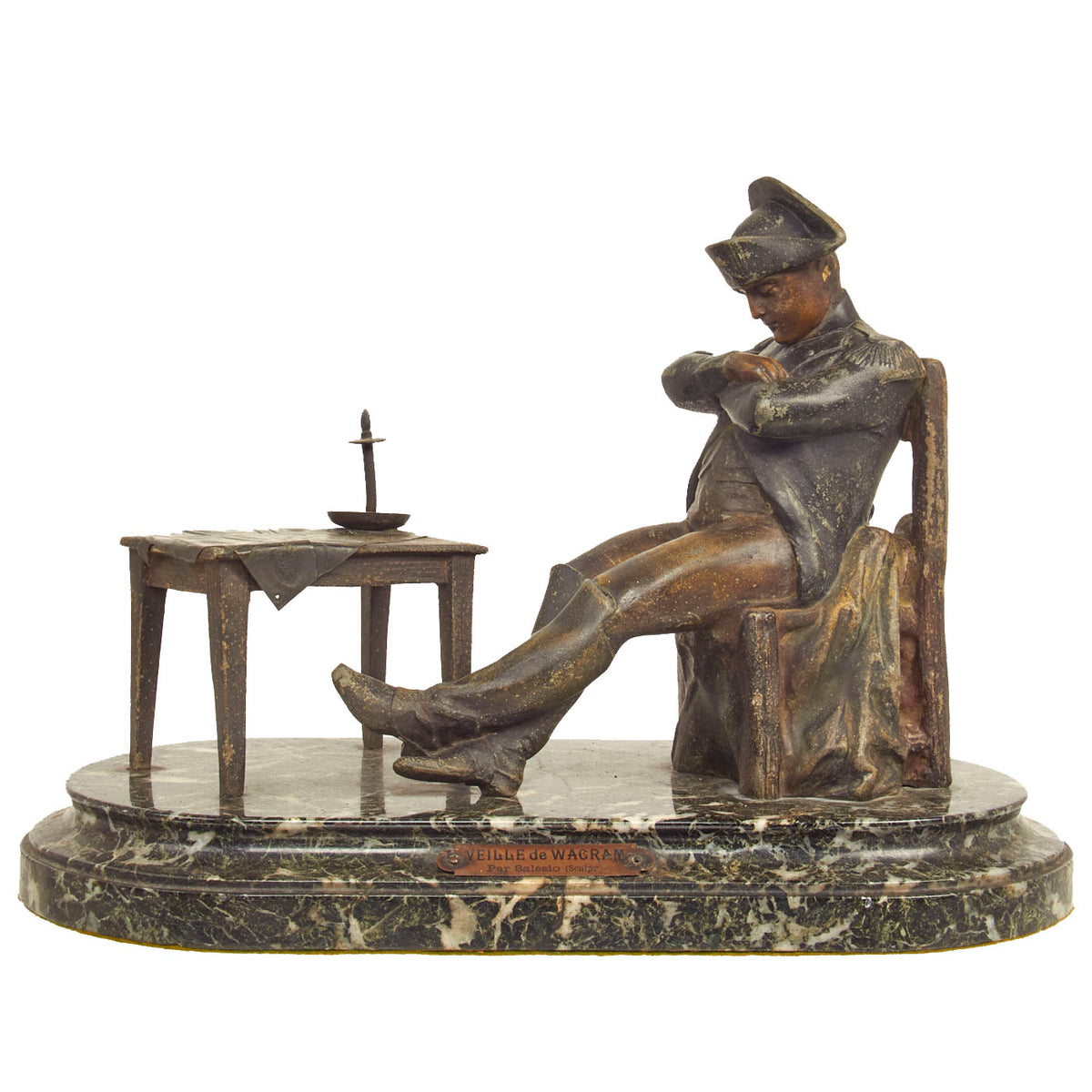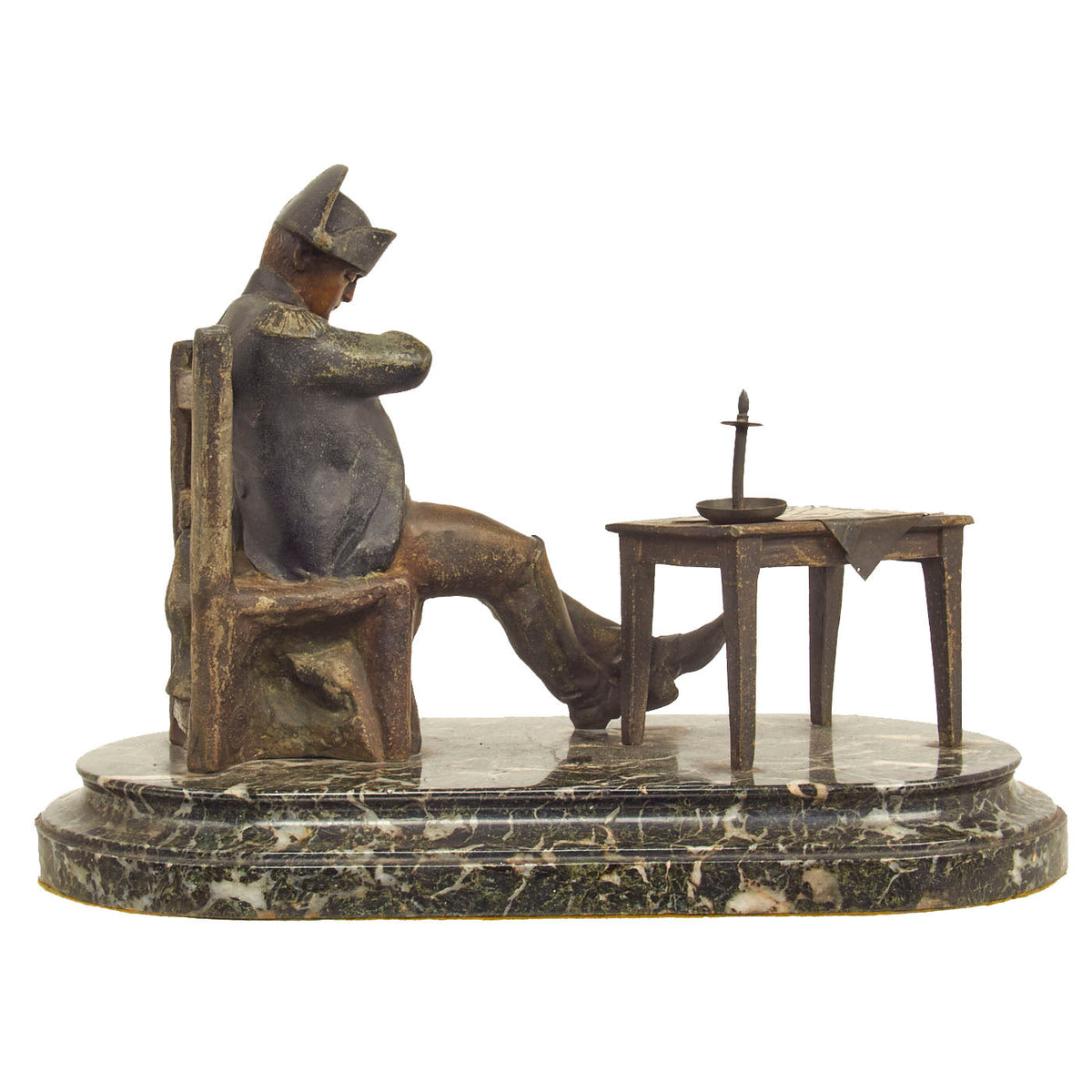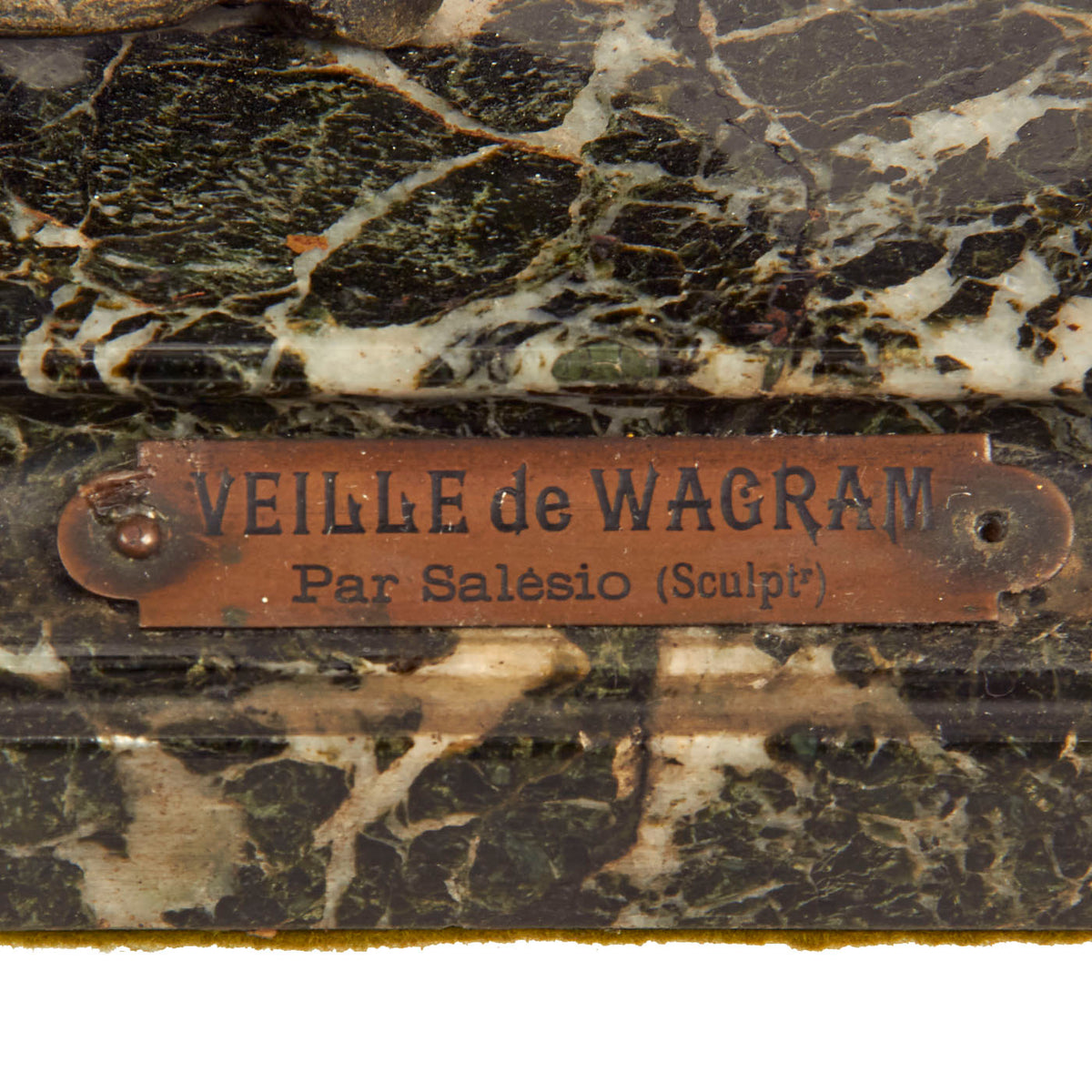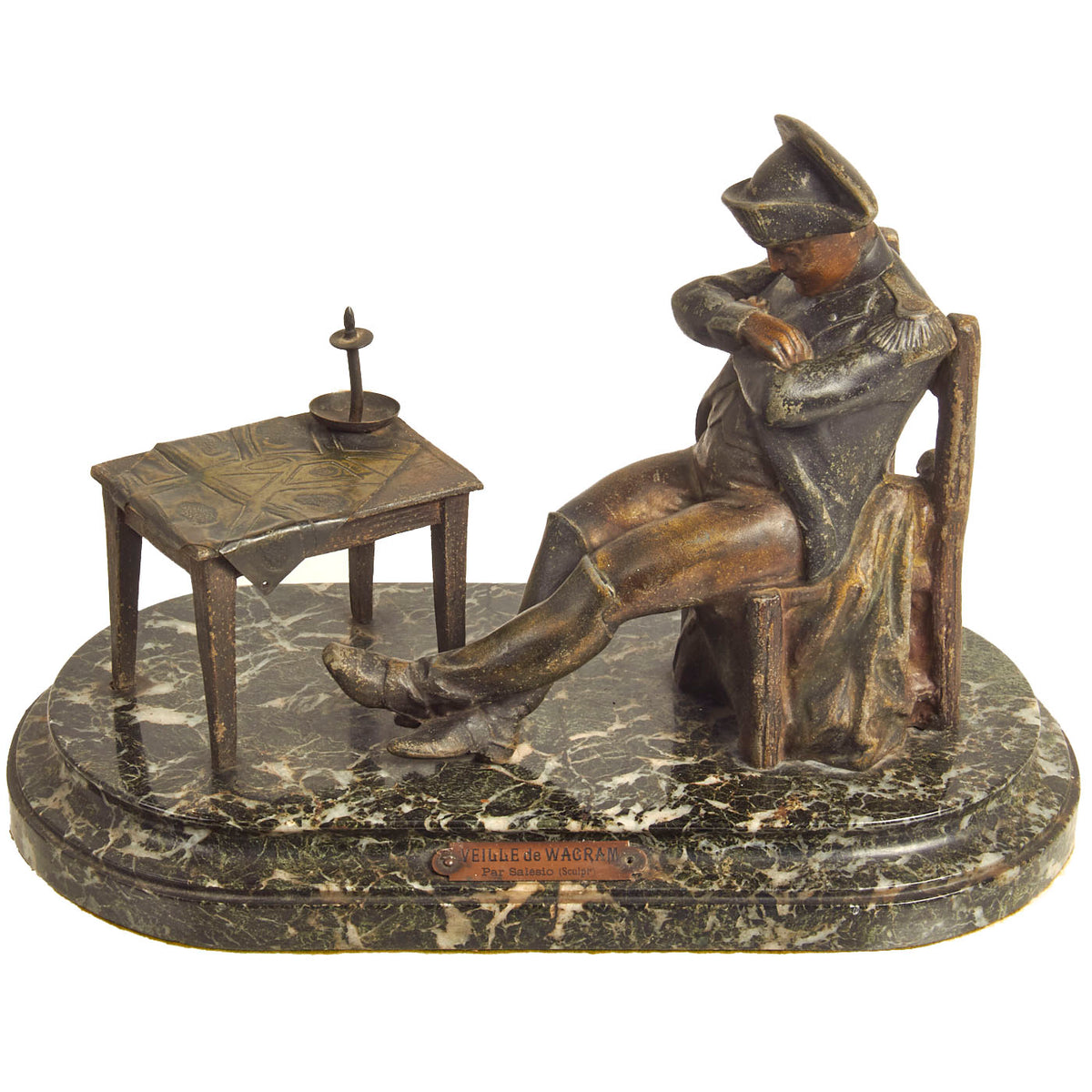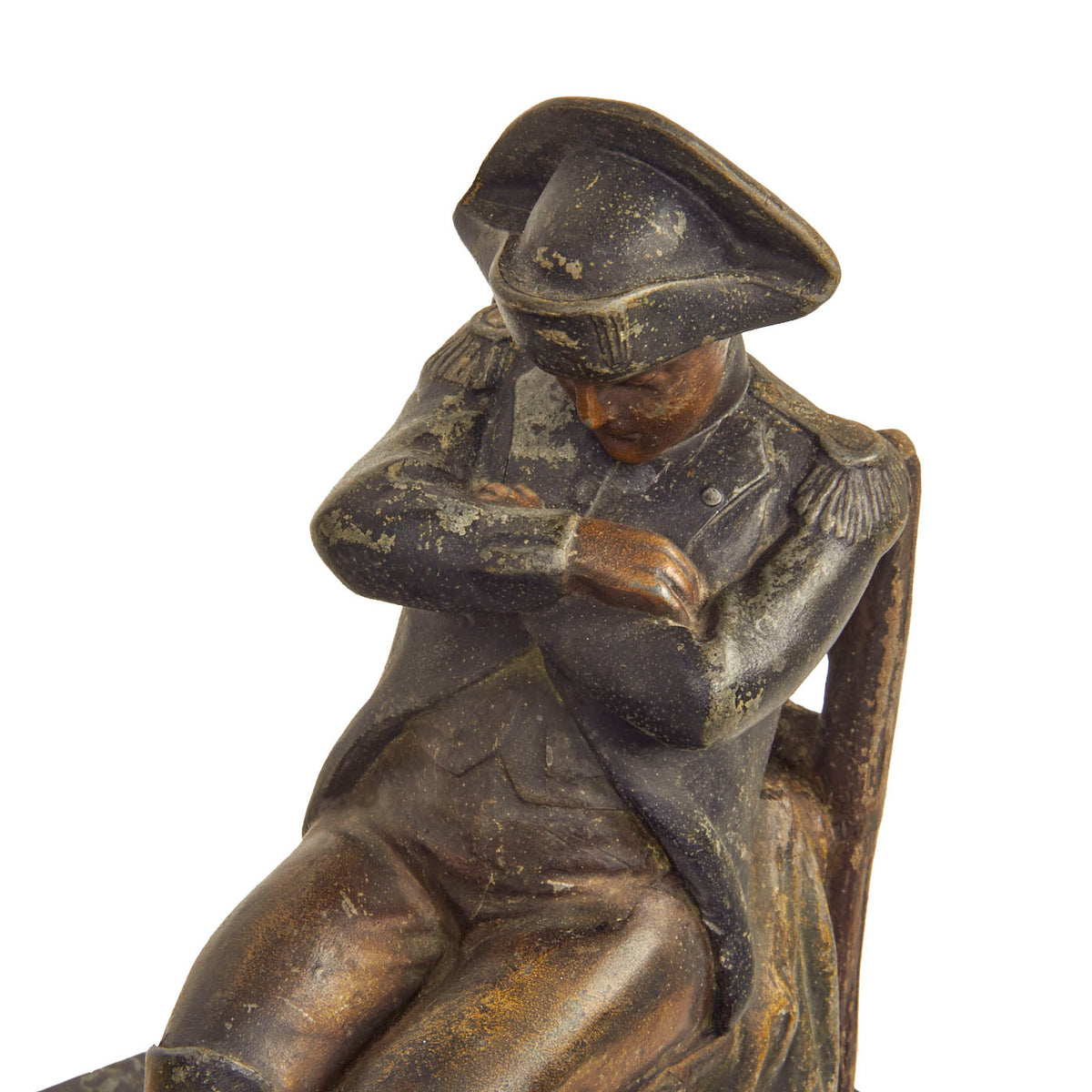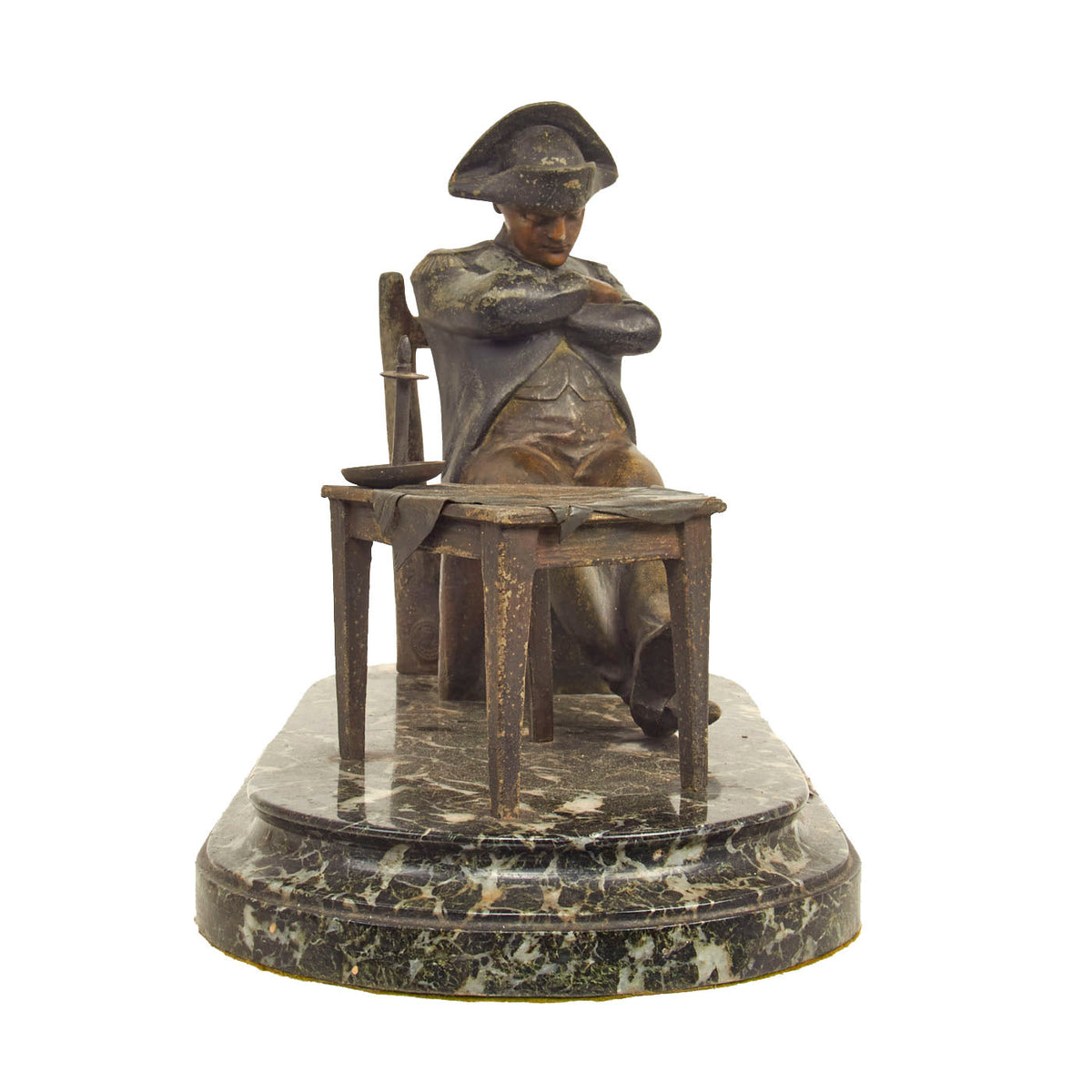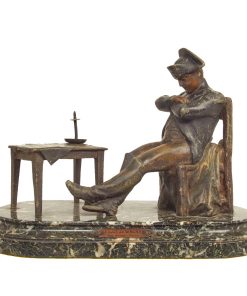Original Circa 1910 French Napoleon Sculpture on Marble Base “Veille de Wagram” (The Eve of Wagram) By Salesio Original Items
$ 595,00 $ 178,50
Original Item: Only One Available. A fantastic original sculpture of Napoleon dating from circa 1910. “Veille de Wagram” or “The Eve of Wagram” features a usually tireless Napoleon Bonaparte, finally succumbing to sleep the evening before the Battle of Wagram in 1809.
The sculpture itself is made of a cast alloy, which was then hand painted a bronze color with darkened accents. The map on the table is constructed of thin sheet brass (which is logical to imitate the appearance of a thin paper map draped on a table). The candlestick is slightly bent, which is only slightly noticeable and does not detract from the outward appearance of the sculpture. The reverse of the painting has an applied circular label which has centered a smelting cauldron and flames. Surrounding the cauldron reads: “Fabrication Francaise/paris/Made in France”.
The handsome carved marble base, which the figures are secured to, is made from a single piece of Arbescato Green/White Marble. The underside of the marble base is fitted with a green sheet of felt to prevent maring of any surfaces, and is in remarkably good condition. The face of the marble base has applied a plaque which reads “VEILLE de WAGRAM/Par Salesio(Sculptr)” One of the original rivets is missing from the plaque, and it appears that some glue was added at one time to further secure the laque to the base. This does not, however, detract from the displayability of the piece in general.
The artist, Salesio, is believed to be Lugli Salesio, who sculpted a variety of pieces such as historical figures, art nouveau works, and so on. Very little is known about this artist.
A handsome classic piece which would make a fantastic addition to a collection, or simply to grace the shelves of one’s study! Ready for display!
The Battle of Wagram, 1809:
The Battle of Wagram (5–6 July 1809) was a military engagement of the Napoleonic Wars that ended in a costly victory for Emperor Napoleon’s French and allied army against the Austrian army under the command of Archduke Charles of Austria-Teschen. The battle led to the breakup of the Fifth Coalition, the Austrian and British-led alliance against France. Wagram was the largest battle in European history up to its time.
In 1809, the French military presence in the Confederation of the Rhine was diminished as Napoleon transferred a number of soldiers to fight in the Peninsular War. As a result, the Austrian Empire saw its chance to recover some of its former sphere of influence and invaded the Kingdom of Bavaria, a French ally. Recovering from his initial surprise, Napoleon beat the Austrian forces and occupied Vienna at the beginning of May 1809. Despite the string of sharp defeats and the loss of the empire’s capital, Archduke Charles salvaged an army, with which he retreated north of the Danube. This allowed the Austrians to continue the war. Towards the end of May, Napoleon resumed the offensive, suffering a surprise defeat at the Battle of Aspern-Essling.
It took Napoleon six weeks to prepare his next offensive, for which he amassed a 172,000-man French, German and Italian army in the vicinity of Vienna. The Battle of Wagram began after Napoleon crossed the Danube with the bulk of these forces during the night of 4 July and attacked the 136,000-man strong Austrian army. Having successfully crossed the river, Napoleon attempted an early breakthrough and launched a series of evening attacks against the Austrian army. The Austrians were thinly spread in a wide semicircle, but held a naturally strong position. After the attackers enjoyed some initial success, the defenders regained the upper hand and the attacks failed. Bolstered by his success, the next day at dawn Archduke Charles launched a series of attacks along the entire battle line, seeking to take the opposing army in a double envelopment. The offensive failed against the French right but nearly broke Napoleon’s left. However, the Emperor countered by launching a cavalry charge, which temporarily halted the Austrian advance. He then redeployed IV Corps to stabilise his left, while setting up a grand battery, which pounded the Austrian right and centre. The tide of battle turned and the Emperor launched an offensive along the entire line, while Maréchal Louis-Nicolas Davout drove an offensive, which turned the Austrian left, and rendered Charles’s position untenable. Towards mid-afternoon on 6 July, Charles admitted defeat and led a retreat, frustrating enemy attempts to pursue. After the battle, Charles remained in command of a cohesive force and decided to retreat to Bohemia. However, the Grande Armée eventually caught up with him and scored a victory at the Battle of Znaim. With the battle still raging, Charles decided to ask for an armistice, effectively ending the war.
With 74,000 casualties, the two-day battle of Wagram was particularly bloody, mainly due to the use of 1,000 artillery pieces and the expenditure of 200,000 rounds of artillery ammunition on a flat battlefield packed with some 300,000 men. Although Napoleon was the uncontested winner, he failed to secure an overwhelming victory and the Austrian casualties were only slightly greater than those of the French and allies. Nonetheless, the defeat was serious enough to shatter the morale of the Austrians, who could no longer find the will to continue the struggle. The resulting Treaty of Schönbrunn meant the loss of one sixth of the Austrian Empire’s subjects, along with some territories, rendering it landlocked until the German Campaign of 1813.
After the battle, Emperor Napoleon bestowed to Louis-Alexandre Berthier, who was his Marshal, Chief of Staff, Minister of War and Vice-Constable of the Empire, the victory title of 1st Prince of Wagram, making him an official member of the French nobility. Berthier had previously been granted the title of Sovereign Prince of Neuchâtel and the Prince of Valangin in 1806. This allowed his descendants to carry the titles of Prince and Princess of Wagram.
Fast Shipping with Professional Packaging
Thanks to our longstanding association with UPS FedEx DHL, and other major international carriers, we are able to provide a range of shipping options. Our warehouse staff is expertly trained and will wrap your products according to our exact and precise specifications. Prior to shipping, your goods will be thoroughly examined and securely secured. We ship to thousands clients each day across multiple countries. This shows how we're dedicated to be the largest retailer on the internet. Warehouses and distribution centres can be located throughout Europe as well as the USA.
Note: Orders with more than one item will be assigned a processing date depending on the item.
Before shipping before shipping, we'll conduct a thorough inspection of the items you have ordered. Today, the majority of orders will be delivered within 48 hours. The delivery time will be between 3-7 days.
Returns
The stock is dynamic and we cannot completely manage it because multiple stakeholders are involved, including our factory and warehouse. So the actual stock may alter at any time. It's possible that you may not receive your order once the order has been made.
Our policy is valid for a period of 30 days. If you don't receive the product within 30 days, we are not able to issue a refund or an exchange.
You can only return an item if it is unused and in the same state as the day you received it. You must have the item in its original packaging.
Related products
Uncategorized
Uncategorized
Australian WWII Owen MK1 Machine Carbine SMG Custom Fabricated Replica with Sling Original Items
Uncategorized
Uncategorized
Uncategorized
Uncategorized
Uncategorized
Uncategorized
Armoured Fighting Vehicles of the World: AFVs of World War One (Hardcover Book) New Made Items
Uncategorized
Uncategorized
Uncategorized
Uncategorized
Uncategorized
Uncategorized
Uncategorized
Uncategorized
Uncategorized
Uncategorized
Angolan Rebel 1970s era 60mm Inert Display Mortar from Angolan Civil War Original Items
